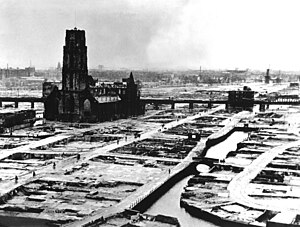การทิ้งระเบิดปูพรม
การทิ้งระเบิดปูพรม (carpet bombing) หรือ การทิ้งระเบิดให้ราบ (saturation bombing) หมายถึงการระดมทิ้งระเบิดทางอากาศสู่พื้นที่ขนาดใหญ่ เพื่อก่อให้เกิดความเสียหายต่อเป้าหมายทุกส่วนบนผืนดินที่ถูกเลือก[1] เปรียบเสมือนการปูพรมทั่วทั้งห้อง ลูกระเบิดที่ใช้ในภารกิจทิ้งระเบิดปูพรมมักเป็นระเบิดไม่นำวิถี


การทิ้งระเบิดปูพรมใส่ชุมชน หมู่บ้าน เมืองใหญ่ หรือพื้นที่ที่มีประชากรหนาแน่น (อันหมายถึงบุคคลที่ได้รับความคุ้มครองตามกฎหมายมนุษยธรรมระหว่างประเทศ) ถือเป็นการก่ออาชญากรรมสงครามตั้งแต่ปี 1977[2] ตามข้อ 51 ของพิธีสาร 1 อนุสัญญาเจนีวา[3][4][5]
อ้างอิง
แก้- ↑ Gooderson, Ian (1997). Air power at the battlefront: Allied Close Air Support in Europe, 1943–45 (1st ed.). London: F. Cass. p. 129. ISBN 0-7146-4680-6.
- ↑ "Crimes of War – Carpet or Area Bombing". คลังข้อมูลเก่าเก็บจากแหล่งเดิมเมื่อ 2 ธันวาคม 2015. สืบค้นเมื่อ 8 ธันวาคม 2015.
- ↑ "Carpet bombing". Britannica.com. สืบค้นเมื่อ June 21, 2019.
- ↑ "Treaties, States parties, and Commentaries - Additional Protocol (I) to the Geneva Conventions, 1977 - 51 - Protection of the civilian population". International Committee of the Red Cross. June 8, 1977. สืบค้นเมื่อ June 21, 2019.
- ↑ "Treaties, States parties, and Commentaries - Additional Protocol (I) to the Geneva Conventions, 1977 - 51 - Protection of the civilian population - Commentary of 1987". Paragraph 5. International Committee of the Red Cross. สืบค้นเมื่อ June 21, 2019.